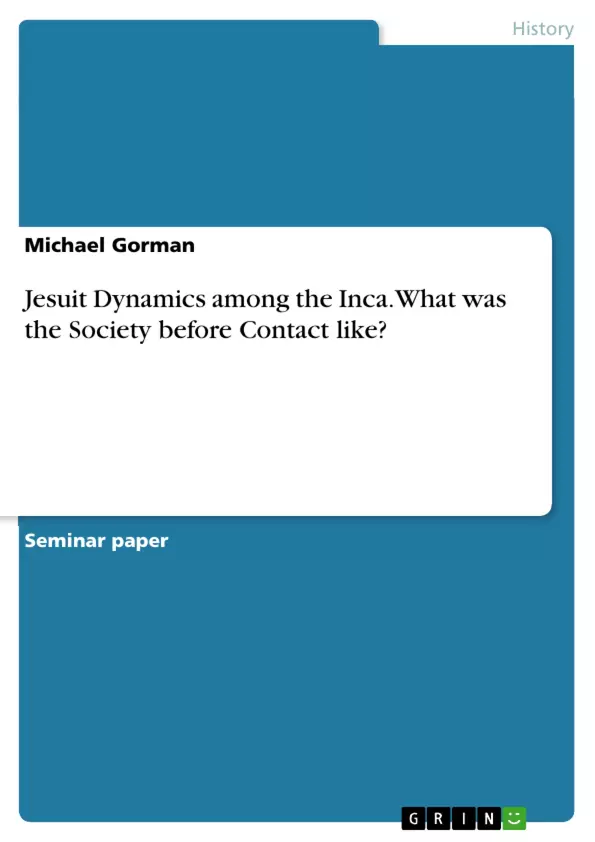Where this study about the Jesuit orders dynamics among the Inca wants to go is beyond race and the casta system, although these will be unavoidable and important aspects of the research. More prominently featured will be aspects such as trade, labor, production, consumption, daily lives, gender, social interaction, what society was like before contact, what was introduced, what was taken away, and what was the final product. The correlation or contest between micro and macro identity will be observed.
Across three centuries, beginning in 1567, the Jesuit order had a substantial political and socio-economic presence in the Andean regions of Latin America. Less than four decades after Saint Ignatius of Loyola founded the Society to spread the faith by the "sword of the word", the first Jesuits entered South America by the request of King Philip II of Spain, altering the chemistry of a continent and two competing empires.
Inhaltsverzeichnis (Table of Contents)
- Jesuit Dynamics Among the Inca
- Historiography of the Jesuits in the Viceroyalty of Peru
- Early Historiography
- Retrospective Historiography
- Modern Historiography
Zielsetzung und Themenschwerpunkte (Objectives and Key Themes)
This study aims to examine the significant role of the Jesuit order in shaping and preserving the cultures of Andean communities during their presence in the Viceroyalty of Peru from 1567 to 1767. It explores the dynamic interplay between the Jesuits, the Spanish Crown, and the Catholic Church, analyzing how Jesuit actions impacted Andean society while considering the differing interpretations of their influence.
- Jesuit impact on Andean culture and identity
- The role of the Spanish Crown in Jesuit activities
- The influence of the Catholic Church on Jesuit actions
- Historical perspectives on Jesuit influence in the Viceroyalty of Peru
- The evolution of historiography regarding the Jesuits and their presence in the Andean region
Zusammenfassung der Kapitel (Chapter Summaries)
- Jesuit Dynamics Among the Inca: This chapter provides an overview of the Jesuit order's substantial political and socio-economic presence in the Andean regions of Latin America from 1567 to 1767. It discusses their arrival in South America and their evolving relationship with the Church and the Spanish Crown.
- Historiography of the Jesuits in the Viceroyalty of Peru: Early Historiography: This section examines the earliest historical accounts of the Jesuits in the Viceroyalty of Peru, focusing on the perspectives of Jesuit figures like Father Bernabé Cobo and their contributions to understanding Andean society and its history. It highlights the concern for the mistreatment of Indigenous populations and the preservation of local culture by various religious orders.
- Historiography of the Jesuits in the Viceroyalty of Peru: Retrospective Historiography: This chapter analyzes the historiography of the Jesuits that emerged following their expulsion from the Viceroyalty of Peru in the mid-18th century. It traces the development of historical narratives that often portray the Jesuits in a negative light, accusing them of disrupting society and opposing progress, particularly during the Enlightenment era.
- Historiography of the Jesuits in the Viceroyalty of Peru: Modern Historiography: This section examines the evolution of historical scholarship on the Jesuits in the Viceroyalty of Peru during the 19th and 20th centuries. It highlights the shift from a purely chronological narrative to a more nuanced and analytical approach that incorporates various social and cultural factors. It also explores how historical perspectives on the Jesuits began to shift, recognizing their contributions to cultural preservation and linguistic studies.
Schlüsselwörter (Keywords)
This study focuses on Jesuit influence, Andean cultures, Viceroyalty of Peru, Spanish Crown, Catholic Church, historiography, colonialism, cultural preservation, Indigenous languages, and historical perspectives.
- Quote paper
- Michael Gorman (Author), 2023, Jesuit Dynamics among the Inca. What was the Society before Contact like?, Munich, GRIN Verlag, https://www.grin.com/document/1363465



